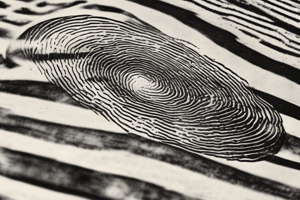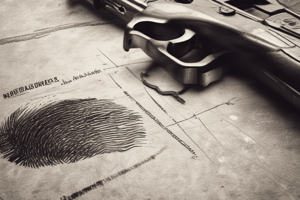Podcast
Questions and Answers
What is the primary objective of this lesson plan?
What is the primary objective of this lesson plan?
- To discuss the physical process by which fingerprints are formed
- To practice locating, developing, and lifting latent fingerprints from various surfaces (correct)
- To identify the equipment needed to record suspect and elimination fingerprints
- To identify the basic evidentiary value of fingerprints found at a crime scene
What is the purpose of obtaining both suspect and elimination fingerprint impressions?
What is the purpose of obtaining both suspect and elimination fingerprint impressions?
- To differentiate between latent and patent fingerprints
- To identify the quality of fingerprint impressions
- To identify the reasons for obtaining both suspect and elimination fingerprint impressions is not provided in the text (correct)
- To determine the pattern groups used to classify fingerprints
What is the purpose of rolling fingerprints on standard ten-print cards?
What is the purpose of rolling fingerprints on standard ten-print cards?
- To practice locating latent fingerprints from various surfaces
- To demonstrate the method used to retrieve fingerprints from various surfaces
- To practice recording suspect and elimination fingerprints (correct)
- To identify the three pattern groups used to classify fingerprints
What will the trainees be able to do after completing this lesson?
What will the trainees be able to do after completing this lesson?
What is the timeframe allocated for this lesson?
What is the timeframe allocated for this lesson?
When was this lesson plan prepared?
When was this lesson plan prepared?
What is the purpose of having the subject wash their hands before taking their fingerprints?
What is the purpose of having the subject wash their hands before taking their fingerprints?
What should be the color of a good fingerprint impression?
What should be the color of a good fingerprint impression?
Why should the subject's fingers be held straight and stiff during the plain impression process?
Why should the subject's fingers be held straight and stiff during the plain impression process?
What can cause poorly prepared fingerprint records?
What can cause poorly prepared fingerprint records?
Why might ridge characteristics be indistinct in some individuals?
Why might ridge characteristics be indistinct in some individuals?
What should be done if a digit is missing during the recording process?
What should be done if a digit is missing during the recording process?
What is the primary composition of a fingerprint?
What is the primary composition of a fingerprint?
What is the most common type of fingerprint pattern found in the population?
What is the most common type of fingerprint pattern found in the population?
What is the purpose of using a flashlight to locate fingerprints at a crime scene?
What is the purpose of using a flashlight to locate fingerprints at a crime scene?
What is the name of the process used to detect oils in perspiration at a crime scene?
What is the name of the process used to detect oils in perspiration at a crime scene?
What is the primary difference between rolled and plain (PAT) fingerprint impressions?
What is the primary difference between rolled and plain (PAT) fingerprint impressions?
What is the name of the system used to store and retrieve fingerprint cards for comparison?
What is the name of the system used to store and retrieve fingerprint cards for comparison?
What is the purpose of using a two-part system on the standard 10-print record card?
What is the purpose of using a two-part system on the standard 10-print record card?
What is the primary advantage of using printer's or commercial fingerprint ink?
What is the primary advantage of using printer's or commercial fingerprint ink?
What is the purpose of using a glass plate in fingerprint recording equipment?
What is the purpose of using a glass plate in fingerprint recording equipment?
What is the primary precaution to take when dusting for fingerprints at a crime scene?
What is the primary precaution to take when dusting for fingerprints at a crime scene?
Flashcards are hidden until you start studying
Study Notes
Fingerprint Evidence
- Fingerprint is a deposit consisting of 98% perspiration, 1% amino acids, and 1% oil that forms on the friction ridges of fingers, palms, and feet, and is left on a surface when contact is made.
Factors Affecting Fingerprint Impression Quality
- Condition of the hand: • Must be clean and dry • Age can affect the friction ridges • Occupation of subject can affect the friction ridges
- Type of Surface: • Smooth, hard, clean surfaces are most likely to reveal prints • Rough, porous, dusty, dirty, or greasy surfaces are least likely to reveal fingerprint impressions • Atmospheric conditions
Fingerprint Classification
- Fingerprints are classified into three pattern types and eight sub-groups: • Arches (5% of population) • Loops (60% of population) • Whorls (35% of population)
Fingerprint Impressions
- There are three types of fingerprint impressions: • Patent (visible) • Latent (invisible) • Plastic (molded)
Fingerprint Recording Equipment and Process
- Standard 10-Print Record Card: • Currently used by most law enforcement agencies • Allows recording of basic pedigree information and rolling of all 10 digits
- Recording Process:
• Preparation: clean hands, glass plate, ink, and roller
• Rolling Impressions:
- Have subject sign 10-print card
- Roll four fingers away from center of subject's body
- Roll thumbs toward center of subject's body
- Apply steady/even downward pressure • Plain (PAT) Impressions:
- Have subject sign 10-print card
- Subject holds fingers together straight and stiff
- Finger printer holds wrist and presses fingers simultaneously on ink pad, then onto print card in appropriate box
Studying That Suits You
Use AI to generate personalized quizzes and flashcards to suit your learning preferences.




